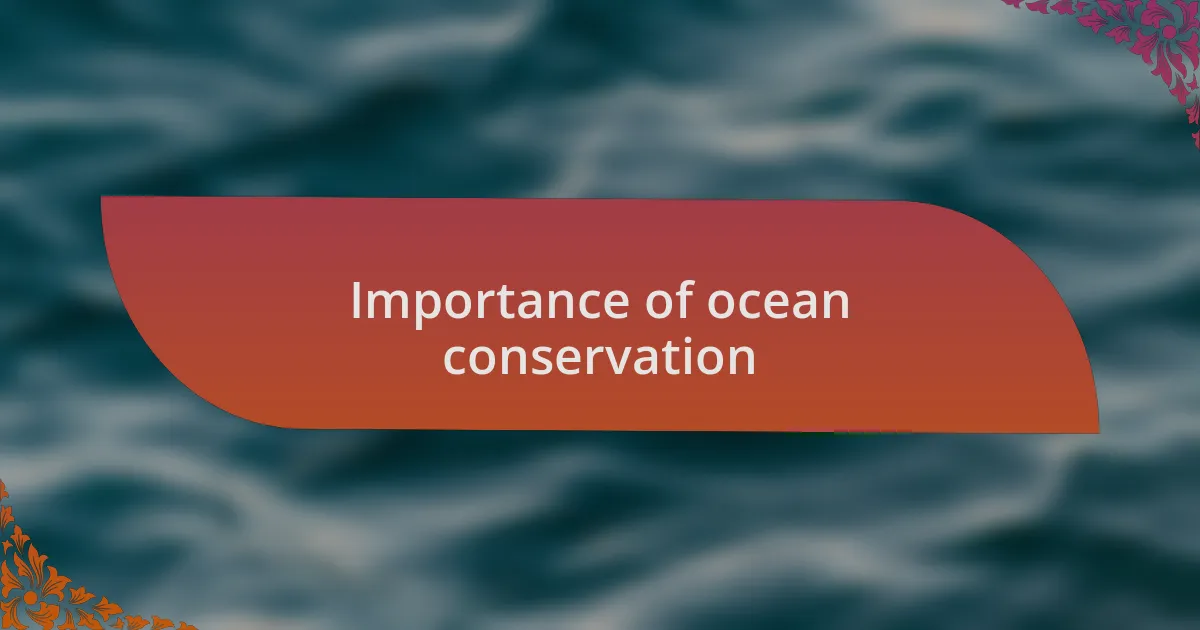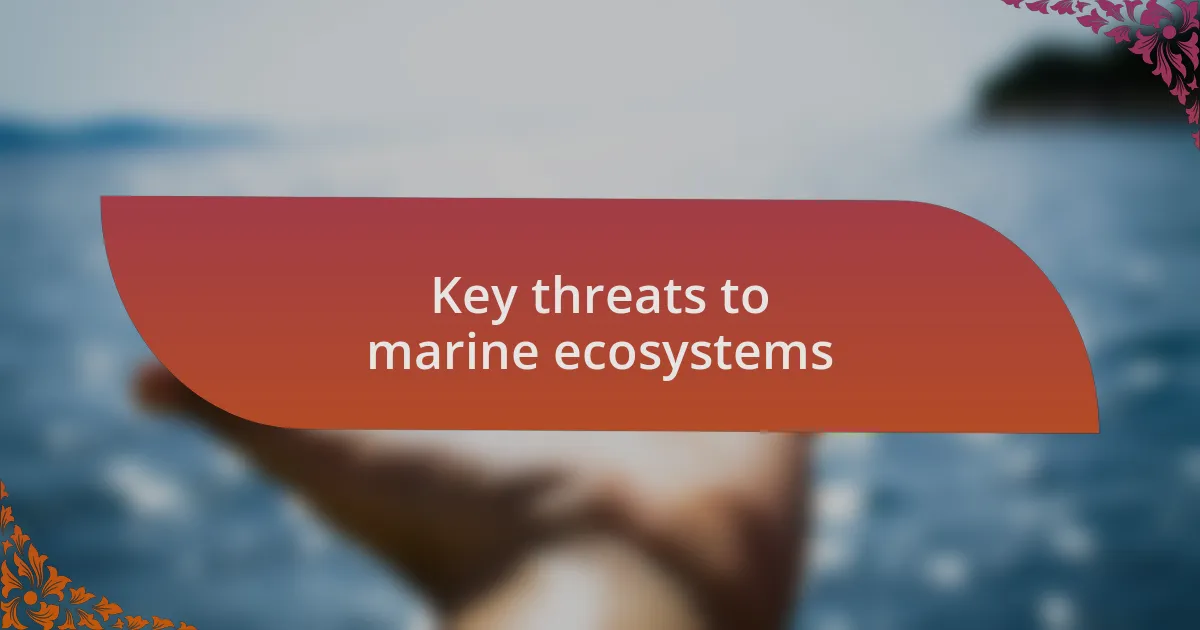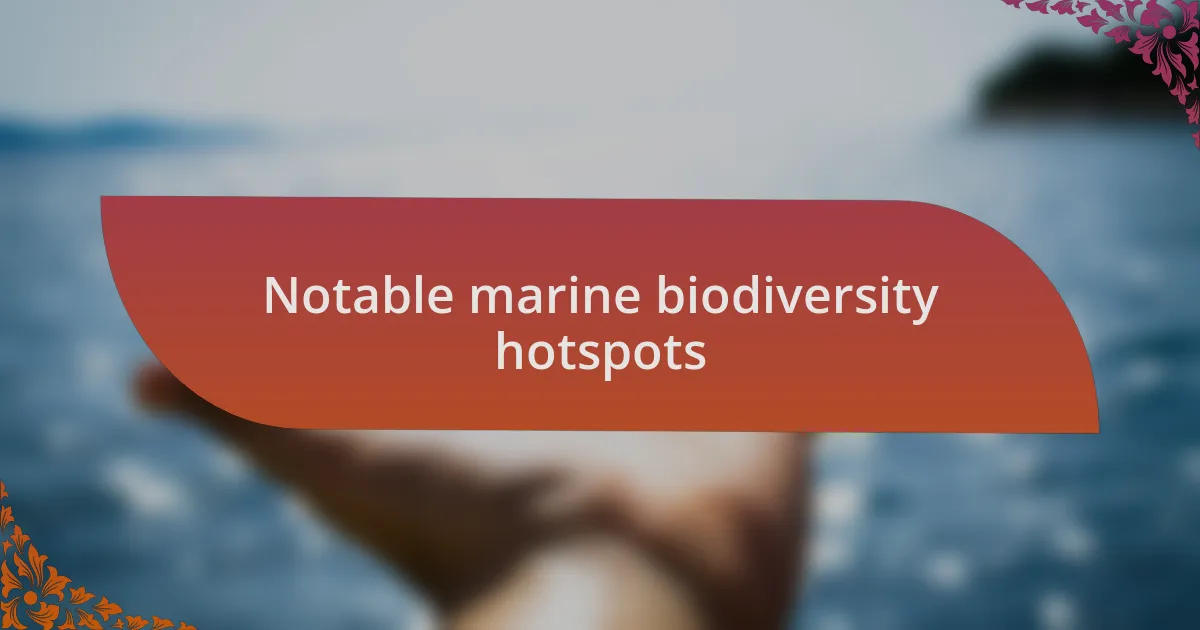Key takeaways:
- Marine biodiversity hotspots are crucial ecosystems facing threats from climate change, pollution, and overfishing, impacting both wildlife and coastal communities.
- Ocean conservation is vital for human survival, influencing air quality and food sources, and requires individual actions to mitigate pollution and protect marine life.
- Notable hotspots like the Great Barrier Reef, Coral Triangle, and Galápagos Islands showcase extraordinary biodiversity but are at risk from overfishing and habitat loss.
- Responsible tourism practices are essential when visiting marine hotspots to preserve ecosystems, emphasizing the importance of education and mindful behaviors among visitors.

Understanding marine biodiversity hotspots
Marine biodiversity hotspots are areas rich in unique species that are under significant threat. Imagine diving into vibrant coral reefs, surrounded by dazzling fish species found nowhere else on Earth. It’s awe-inspiring to think about how these ecosystems are irreplaceable, yet they face relentless pressures from climate change, pollution, and overfishing.
Have you ever witnessed the sheer variety of life in a single kelp forest? I recall snorkeling through one, mesmerized by the colors and movements all around me. Each species plays a role in the ecosystem, creating a delicate balance that, when disrupted, can lead to a cascading effect of loss. It makes you wonder, how much more beauty and diversity are we willing to sacrifice before it’s too late?
In my travels, I’ve often observed that these hotspots are not just crucial for the planet’s health, but they also hold cultural significance for many coastal communities. These regions support livelihoods, traditions, and identities. What happens to these communities when their marine resources dwindle? The interconnectedness of nature and humanity in biodiversity hotspots is profound, and recognizing this relationship is essential for effective conservation efforts.

Importance of ocean conservation
The importance of ocean conservation cannot be overstated. I remember standing on a beach at sunrise, gazing at the horizon, reflecting on how the ocean impacts every aspect of our lives. From the air we breathe to the food on our plates, the health of our oceans is intertwined with our survival. How can we afford to neglect such a vital resource?
When I participated in a coastal cleanup, I was struck by how much debris washed ashore—plastic bottles, fishing nets, and more. Each piece of trash represents a potential threat to marine life. It made me realize that our individual actions matter significantly; even small changes in our habits can contribute to larger conservation efforts. Are we truly willing to change our behaviors for the sake of the ocean’s well-being?
Moreover, I find it fascinating how vibrant marine ecosystems directly influence climate regulation. For instance, healthy coral reefs not only support biodiversity but also act as natural barriers against storms and rising sea levels. As someone who cherishes the tranquility of the ocean, I can’t help but think: what will future generations inherit if we fail to act now?

Key threats to marine ecosystems
One of the key threats to marine ecosystems is overfishing. I’ve seen firsthand the once-abundant schools of fish diminish in certain areas, a stark reminder of how rapidly our oceans can be depleted. It leaves me wondering: what will happen to the delicate balance that so many marine species rely on?
Pollution is another significant danger, with plastic waste infiltrating even the most remote ocean regions. During my travels to a remote archipelago, I was shocked to find plastic fragments on pristine shores. It was a poignant moment that made me question how our convenience comes at such a high cost to marine life — fish are ingesting microplastics, which harms their health and can even enter our food chain.
Lastly, climate change poses an existential threat, leading to ocean acidification and warming waters. I recall diving in a vibrant reef that had transformed into a ghostly landscape due to bleaching. This left me with a heavy heart as I considered the resilience of ecosystems. Are we prepared to witness further loss, or will we finally prioritize action to protect these invaluable habitats?

Notable marine biodiversity hotspots
When I think of notable marine biodiversity hotspots, the Great Barrier Reef immediately comes to mind. This immense ecosystem dazzled me during my first snorkeling trip; the vibrant colors and diverse marine life were simply breathtaking. However, witnessing parts of this masterpiece struggling with coral bleaching was a stark reminder that even natural wonders are not immune to our actions.
Another hotspot that has left an indelible mark on me is the Coral Triangle in Southeast Asia, often dubbed the “Amazon of the seas.” The sheer diversity of species found here is incredible. I once swam alongside a gentle giant— a whale shark— gliding effortlessly through crystal-clear waters, a moment that felt almost surreal. It’s disheartening to think that overfishing and habitat loss threaten this vibrant sanctuary. How can we cherish such beauty yet allow it to slip away?
Lastly, I must highlight the Galápagos Islands, where unique marine life thrives. Stepping into the water was like diving into a living classroom; I observed the playful sea lions and the majestic marine iguanas. Such experiences fuel my passion for conservation, yet I can’t help but wonder, as tourism increases, what measures are being taken to preserve this ecological treasure? The delicate balance here teaches us that we must cherish and protect these hotspots before they fade into memory.

My experiences in marine hotspots
My experiences in marine hotspots
Diving into the waters off the coast of Belize was like entering an underwater paradise. I remember my heart racing as I swam alongside a vibrant school of parrotfish, their scales shimmering under the sunlight. Each encounter reminded me of the intricate connections within marine ecosystems and left me wondering how fragile this beauty truly is amidst rising sea temperatures.
On another occasion, I explored the ancient kelp forests of California. As I swam through towering kelp, I was captivated by the graceful movements of sea otters playing above me. What struck me most was the sense of tranquility and the unyielding resilience of these ecosystems. Yet, it broke my heart to realize that pollution and climate change are constant threats to these astounding underwater worlds.
Finally, my journey to the Seychelles revealed a stunning blend of creativity and life in the ocean. While snorkeling near a coral reef, I encountered an octopus changing colors in a mesmerizing display. It made me reflect on the wonders of adaptation and survival. How can we, as stewards of the ocean, ensure that such remarkable creatures continue to thrive in a rapidly changing world? Each moment spent in these hotspots not only deepens my appreciation for marine biodiversity but ignites a fiery passion within me to advocate for their protection.

Sustainable practices for visiting hotspots
When I prepared for my first trip to a marine hotspot, I made it a point to research the local guidelines for sustainable tourism. I remember the excitement of learning about eco-friendly tour operators who prioritize conservation and minimize their impact on the environment. Choosing responsible guides not only enhances the experience but contributes to the preservation of these breathtaking ecosystems.
During one unforgettable diving expedition, I witnessed firsthand the effects of responsible tourism. With every careful movement, I was reminded to avoid touching the coral, respecting its delicate nature. Left in awe, I thought: How simple changes in our behavior could lead to lasting benefits for underwater environments. It truly emphasizes the importance of educating ourselves before immersing in these wonders.
As I savor the memory of the vibrant marine life I’ve encountered, I often reflect on the collective responsibility we share as visitors. Practicing the principle of “leave no trace” in marine spaces, such as not collecting shells or disturbing wildlife, made me question: How can each of us leave behind a positive impact on these precious ecosystems? Ultimately, every mindful action adds up to a significant difference in ensuring future generations can enjoy the beauty of these hotspots.